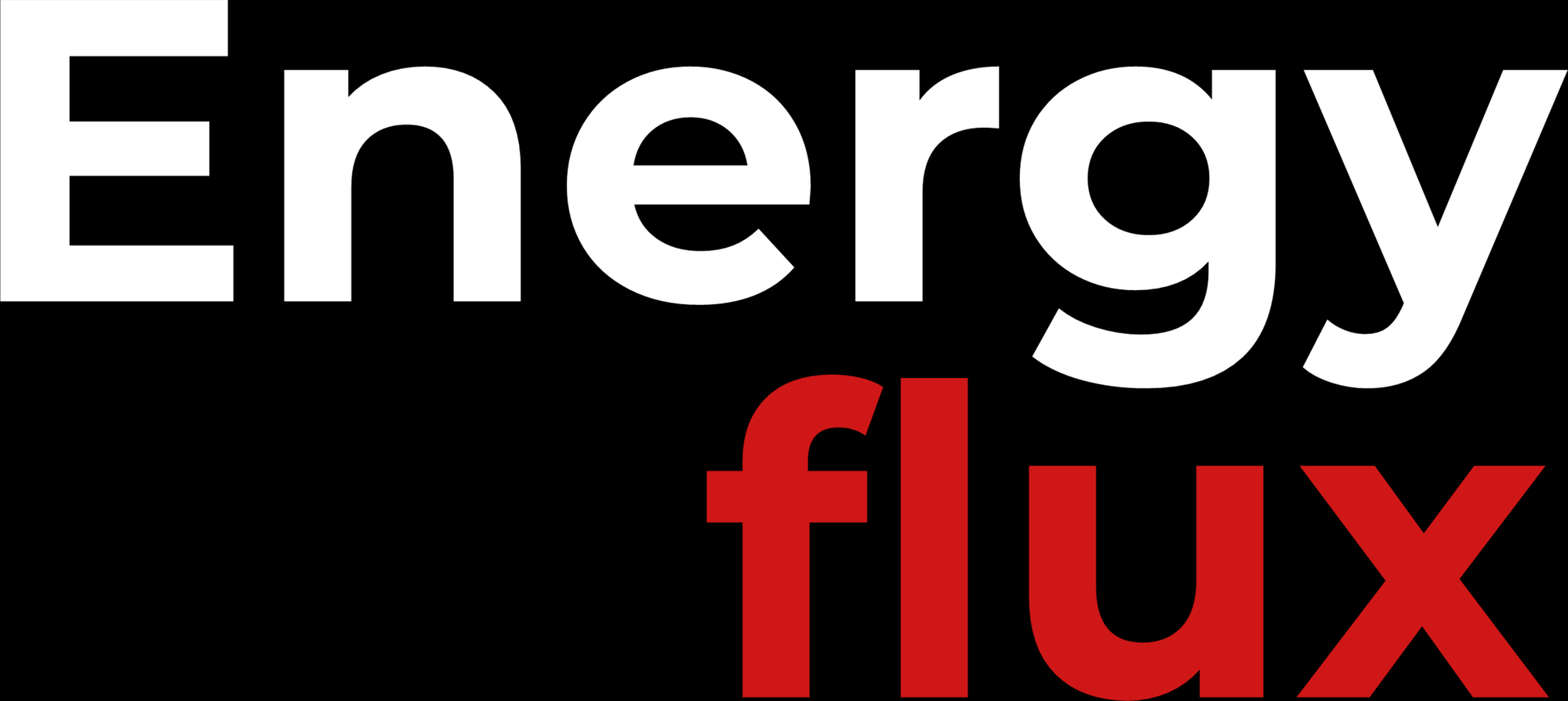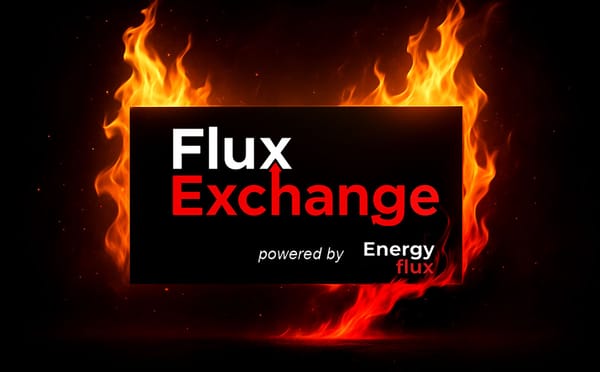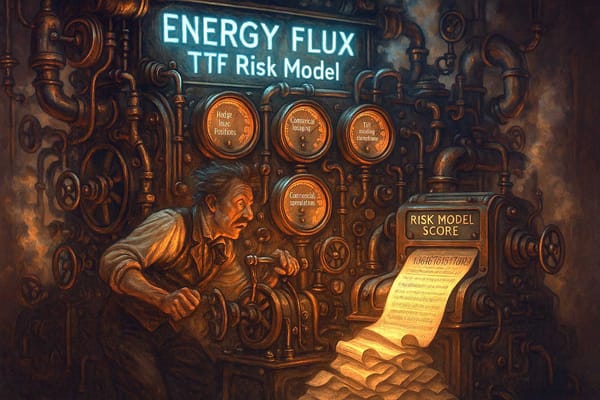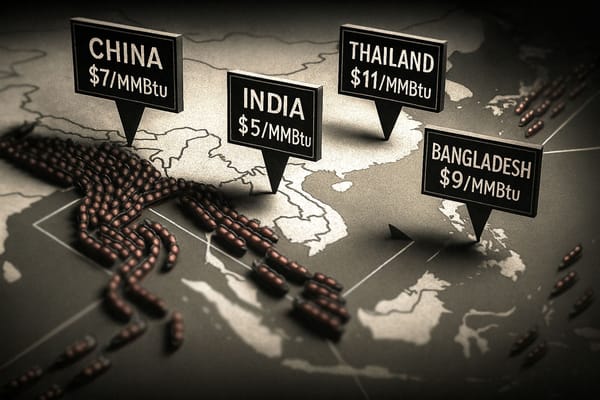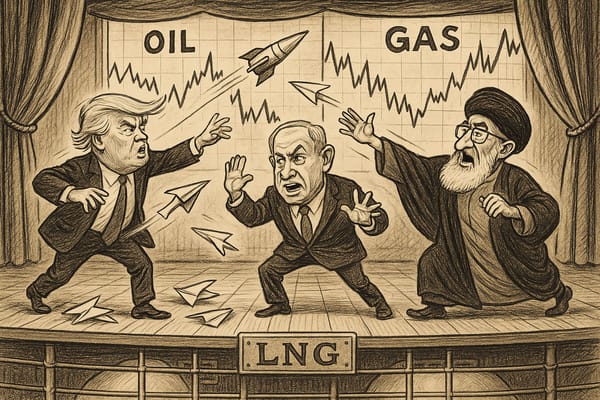🎧 Fickle trade war takes its toll on LNG demand
PLUS: Listener Q&A on TTF price outlook, US LNG risks, and Jeff Currie's The New Joule Order
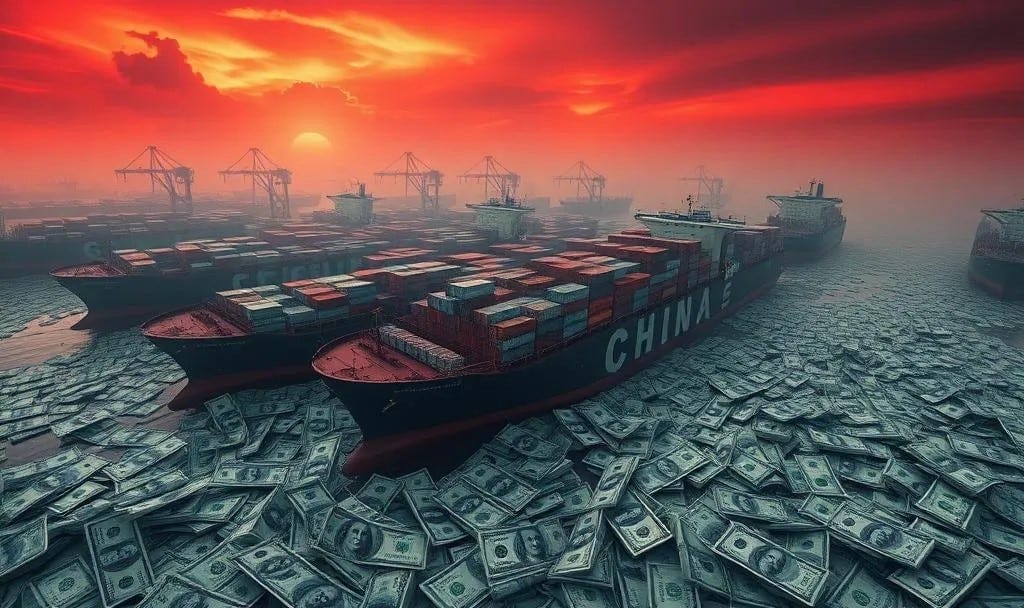
The US-China trade war has rewritten the macroeconomic outlook for 2025, and with it the global demand picture for liquefied natural gas (LNG).
Swingeing import tariffs could be lifted just as quickly as they were introduced. However, even a swift resolution at this stage would be unlikely to purge the bearish sentiment now dominating the European natural gas market.
This episode catches up on the many market-moving events of recent weeks, with a focus on disruption to energy trade, relaxation of the EU’s gas storage targets, and bearish factors weighing on the summer gas demand outlook.
In the reader Q&A, I fielded questions relating to my recent take on the shift to a new lower pricing regime, and the risks posed by a cratering price environment to customers buying US LNG.
I also share my thoughts on The New Joule Order, a thought-provoking essay from esteemed energy commodities analyst Jeff Currie.
The full transcript is included below.
Thanks for listening,
— Seb
P.S. Don’t forget to share your questions, thoughts and reactions for inclusion in the next episode. I prioritise input from paid subscribers 😉
More from Energy Flux:
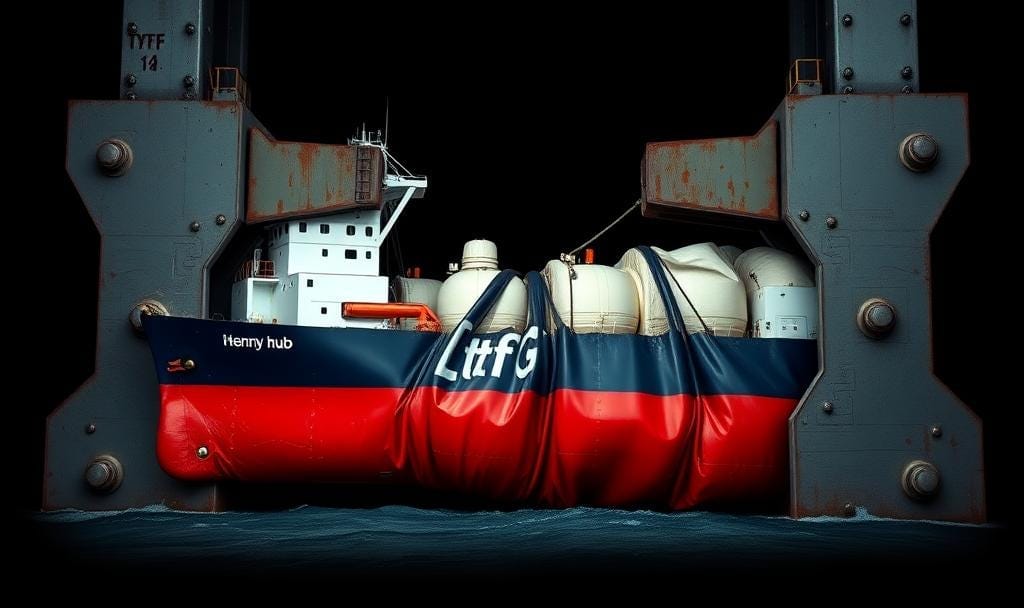


Episode transcript:
(00:00:19):
Hi there, and welcome back to Energy Flux On Air.
(00:00:23):
I'm your host,
(00:00:24):
Seb Kennedy,
(00:00:25):
founding editor of Energy Flux,
(00:00:28):
the energy newsletter analyzing European natural gas and global LNG markets through
(00:00:34):
the lens of Europe's energy transition and global geopolitics.
(00:00:38):
It's been quite a while since my last episode.
(00:00:41):
I've been quite busy with the house move, transatlantic travel, Easter break.
(00:00:45):
So apologies for those of you who have missed energy flux on air.
(00:00:50):
I've been dying to get back into the studio to talk over everything going on in
(00:00:53):
energy markets and the global geopolitical panorama.
(00:00:56):
And I finally found time and I'm hoping to get back onto a more regular recording schedule.
(00:01:02):
To give a measure of how much time has elapsed since the last episode,
(00:01:05):
the price of European gas traded on the Tidal Transfer Facility,
(00:01:10):
that's the TTF,
(00:01:11):
the European benchmark,
(00:01:12):
has dropped from more than 43 euros per megawatt hour on the 19th of March to less
(00:01:18):
than 32 euros at the end of last week.
(00:01:21):
That's a drop of more than a quarter in barely more than a month.
(00:01:25):
Since the last episode,
(00:01:27):
we've had Liberation Day,
(00:01:28):
the start of a bitter Sino-US trade war with both sides seemingly entrenched,
(00:01:34):
a stock market shock,
(00:01:35):
bond markets wavering,
(00:01:37):
dollar devaluation and a rewriting of both the global macroeconomic script and the
(00:01:42):
security guarantees.
(00:01:43):
that underpinned 80 years of global trade since the Second World War.
(00:01:48):
So TTF settled on Friday below €32 per megawatt hour,
(00:01:52):
but that's the first time it's been that low in a year.
(00:01:55):
€32 is approximately $10.80 per MMBTU.
(00:02:01):
And that sell-off has,
(00:02:03):
as usual,
(00:02:04):
correlated quite strongly with a sell-off in hedge fund long positions.
(00:02:09):
The hedge funds that bet on the future price of TTF, as you'll recall, they had an eye-watering
(00:02:16):
net long position of 292 terawatt hours and that was in February when the price on
(00:02:24):
TTF was reaching for 60 euros per megawatt hour we've seen massive liquidations two
(00:02:30):
big sell-off periods in February and in April April of course being triggered by
(00:02:34):
the Liberation Day trade war which I mentioned at the start net position went from
(00:02:38):
292 terawatt hours to just 86 terawatt hours
(00:02:42):
or a 15 billion euros long bet to a 5 billion bet.
(00:02:48):
So essentially the hedge funds have sold off 10 billion euros worth of length in
(00:02:54):
TTF futures since February.
(00:02:57):
But I don't think the sell-off has finished.
(00:03:00):
And the reason I say that is because if you go back 12 months to when TTF was last
(00:03:06):
trading at around about the 32 euro per megawatt hour mark,
(00:03:11):
then at that point,
(00:03:13):
hedge funds had a net bullish position of,
(00:03:17):
on average,
(00:03:17):
62 terawatt hours throughout April 2024.
(00:03:20):
And we're currently 86 terawatt hours.
(00:03:24):
So if anything,
(00:03:26):
you could say that while the momentum is towards further sell-off,
(00:03:30):
to the extent that the historical correlation between price levels and net position
(00:03:35):
is an indicator of where equilibrium lies,
(00:03:38):
then you could argue that
(00:03:39):
further sell-offs are required to get down to sort of 62-ish terawatt hours.
(00:03:44):
And depending on how bearish this summer turns out to be in terms of physical demand,
(00:03:49):
policy changes,
(00:03:50):
geopolitical developments,
(00:03:52):
then it's entirely feasible to imagine there being,
(00:03:56):
I mean,
(00:03:56):
you know,
(00:03:57):
the hedge funds,
(00:03:57):
they do go net short.
(00:04:00):
um when the market flips extremely bearish so it's not out of the question that the
(00:04:04):
entire net position could be sold off and hedge funds could start shorting ttf on a
(00:04:09):
net basis anyway so since the last episode there's also been some interesting
(00:04:12):
developments on the policy front so the european parliament's energy committee has
(00:04:16):
voted to lower the eu's gas storage targets to 83 by the first of november and to
(00:04:24):
scrap the intermediary targets
(00:04:26):
So you'll recall the EU has this target.
(00:04:28):
Everybody had to reach a certain percentage fill level every two months throughout
(00:04:33):
the filling season.
(00:04:34):
But that's probably not going to matter.
(00:04:36):
There have been several policy suggestions and proposals and it's all open to negotiation still.
(00:04:42):
But the direction of travel is very firmly towards a place where it looks like the
(00:04:47):
gas storage targets essentially are meaningless.
(00:04:50):
And they're just a guide because...
(00:04:53):
you know after all is said and done after everybody's negotiated and the
(00:04:57):
derogations have been issued and the exceptions have been carved out what really
(00:05:01):
matters is is there a penalty for non-compliance for falling short of your gas
(00:05:07):
storage fill level and there never really was one and there were measures that
(00:05:10):
could be taken but there was never actually a financial penalty to be levied upon
(00:05:14):
the gas storage operators and i did say last year you need to watch their behavior
(00:05:18):
the gas storage operators to what extent are they going to comply
(00:05:22):
um and potentially not necessarily bankrupt themselves but you know lose a lot of
(00:05:26):
money just in the name of compliance with an arbitrary target for refilling these
(00:05:31):
massive underground gas storage facilities and evidently uh i think when there's no
(00:05:37):
penalty then it's an easy decision to take you know why would you lose money
(00:05:41):
storing expensive gas to sell it at a loss in the future and pay all the storage
(00:05:45):
costs associated with that just to comply with a target which
(00:05:49):
is only arbitrary and doesn't carry a penalty for non-compliance so i think that
(00:05:53):
one was quite easy to predict and it seems like it's going to be that way this year
(00:05:57):
not to say that europe doesn't need to buy gas this summer absolutely does need to
(00:06:01):
buy gas needs to get some gas into storage for next winter but
(00:06:05):
The physical panorama in the market is looking relatively loose.
(00:06:08):
We've got some new LNG projects coming on stream this summer.
(00:06:12):
The pan-EU scramble to procure gas will not occur in a way that drives up prices,
(00:06:19):
and there will be probably more measured procurements,
(00:06:22):
and I think
(00:06:23):
paying very close attention to the price spreads,
(00:06:26):
calendar spreads,
(00:06:27):
to make sure that the gas storage operators aren't taking on an undue amount of
(00:06:31):
price risk by storing gas at prices they can't then recover their costs from.
(00:06:37):
So the TTF term structure is now pretty flat.
(00:06:41):
The negative spreads that were blighting the markets over the kind of tight winter
(00:06:47):
months when the bull run was in full swing,
(00:06:49):
those essentially corrected themselves.
(00:06:52):
So we did have a situation where gas was cheaper in the future than in the present
(00:06:58):
month or the front month.
(00:06:59):
And obviously that was a big disincentive for storing because you wouldn't store
(00:07:03):
something that's going to get less valuable over time and incur costs for doing so.
(00:07:07):
but still the the signal the market signal for storing gas is very weak you need to
(00:07:15):
have a sufficient spread between the price of gas at the time of procurement and
(00:07:22):
the winter months when you're hedging in your sales to obviously cover your costs
(00:07:28):
your storage costs your cost of capital and hopefully you know to make a margin if
(00:07:32):
you're a
(00:07:33):
If you're a commercial player, not all gas storage operators are.
(00:07:36):
Some are mandated to operate in a strategic way,
(00:07:39):
but some are commercial operators and they do need to make some money.
(00:07:42):
But either way, none of them want to lose money.
(00:07:43):
A negative spread would have implied a loss on storage, which is why there was this...
(00:07:49):
Debates in Europe about,
(00:07:50):
well,
(00:07:50):
do we subsidise the cost of refilling our gas storage facilities?
(00:07:54):
I don't think that's going to happen now.
(00:07:55):
It doesn't seem necessary.
(00:07:57):
And there is a much more relaxed approach to how the gas storage capacity in Europe
(00:08:02):
should be managed.
(00:08:03):
That's only a good thing,
(00:08:04):
because it seems that politicians are taking a much more realistic view to...
(00:08:09):
how the gas market will pan out over the next sort of 12 to 18 months.
(00:08:14):
When,
(00:08:14):
of course,
(00:08:15):
if you've been reading energy flux,
(00:08:16):
you'll be aware that my view is very strongly that we're heading towards a new
(00:08:21):
pricing regime because of the way that the global liquefied natural gas market is
(00:08:27):
developing with the onset of new supply,
(00:08:31):
which is coming into the market at a rate that exceeds the rate of demand growth.
(00:08:36):
So if the supply growth outstrips demand growth,
(00:08:38):
then you have a loose market where there is a kind of nominal surplus.
(00:08:45):
And that will just mean that prices have to go lower in order for the market to
(00:08:49):
find its equilibrium and then for that supply to be soaked up.
(00:08:54):
And you will see that happen.
(00:08:55):
You will see price sensitive demand come back into the markets in markets like Bangladesh,
(00:09:00):
Pakistan.
(00:09:00):
Pakistan, maybe Vietnam, where you'll see energy imports increase as the price goes lower.
(00:09:06):
But right now we're seeing,
(00:09:08):
in terms of the physical balances,
(00:09:10):
EU energy imports hit a record in the first quarter of 2025.
(00:09:13):
They dropped off in April.
(00:09:15):
as demand fell away.
(00:09:17):
Asian demand is also very soft.
(00:09:19):
We've seen Chinese imports flagging quite a bit.
(00:09:21):
Weekly imports of LNG have come in at the lower end of the five-year range since
(00:09:26):
late 2024 and throughout 2025,
(00:09:28):
according to data from data provider Kepler.
(00:09:31):
And Kepler,
(00:09:32):
in fact,
(00:09:32):
their analysts ran some interesting figures recently around the way that the softer
(00:09:38):
macroeconomic outlook was impacting gas markets or likely to impact gas markets.
(00:09:43):
And while this isn't their central scenario,
(00:09:45):
they did say,
(00:09:46):
let's have a look at the worst case macro scenario in combination with the
(00:09:49):
potential for a cool summer.
(00:09:51):
So rather than there being lots and lots of heat waves where you have lots of
(00:09:56):
cooling demand for running air conditioning,
(00:09:58):
driving power prices crazy and people shipping in LNG vessels to fire those gas
(00:10:03):
turbines to run the AC units.
(00:10:06):
If you get a cool summer where that doesn't happen, plus you get like the worst possible...
(00:10:11):
macroeconomic outlook from a trade war,
(00:10:14):
then essentially you are looking at 7.5 million tonnes of LNG demand disappearing
(00:10:20):
from the market.
(00:10:22):
7.5 MT,
(00:10:23):
that's an equivalent of about one month of EU LNG demand,
(00:10:27):
like an entire month of LNG imports for the whole of the EU just gone.
(00:10:32):
That kind of bearish view was backed up by the Oxford Institute for Energy Studies,
(00:10:36):
which says that a year-on-year decline in EU gas demand is a very real possibility
(00:10:42):
for this year.
(00:10:43):
So in summary, I'd say the market's looking very bearish.
(00:10:46):
The bearish setup is undeniable.
(00:10:48):
And it seems like there won't even be a sort of policy-induced scramble to inject
(00:10:53):
gas into storage facilities in Europe to support LNG demand this summer.
(00:10:56):
So it'll be interesting to see...
(00:10:58):
quite where the equilibrium lies,
(00:11:00):
how low the prices go this summer,
(00:11:02):
because obviously there will be some procurements.
(00:11:04):
But at the same time, the industrial sector is very much on its knees still.
(00:11:08):
There's no signs of an industrial recovery on the horizon.
(00:11:13):
And the power sector,
(00:11:14):
we're already seeing very,
(00:11:16):
very steep negative pricing in the power sector in day-ahead markets.
(00:11:19):
We saw all across continental Europe today.
(00:11:21):
This is Sunday, the 27th of April, I'm recording.
(00:11:24):
And many parts of North, Central and Western Europe were registering negative prices.
(00:11:30):
So you're not going to see any gas-fired generation dispatching when power prices
(00:11:35):
are minus 10,
(00:11:35):
20,
(00:11:36):
100 euros per megawatt hour.
(00:11:41):
Now, moving on to reader questions.
(00:11:44):
So James in Adelaide, he's written in to say,
(00:11:56):
I'm not sure I would call $11 gas, quote unquote, glut economics.
(00:12:02):
And that's a phrase that I used in a recent piece in Energy Flux,
(00:12:06):
saying that the correction and sell-off,
(00:12:09):
taking gas down to the equivalent of $11 per mbtu was sort of a signal of a glut coming.
(00:12:15):
James carries on, he says, I guess the question is, where do we settle as a floor?
(00:12:19):
in the coming years and for how long and he says anecdotally by the way I was in
(00:12:23):
Europe a fortnight ago and most corporates as in utilities and LNG producers were
(00:12:27):
saying that between 50 and 70 billion cubic meters per annum of Russian gas is
(00:12:32):
going to come back including a certain French super major naming no names who said
(00:12:37):
that 80 BCM could return but they're still buying US LNG
(00:12:41):
In which case,
(00:12:42):
do we bump along a sort of $6 MMBTU floor for several years because of a US
(00:12:47):
capacity overbuild?
(00:12:48):
And who wears the most pain?
(00:12:50):
Likely the portfolio players buying USLNG that haven't sold to an end customer yet.
(00:12:56):
And maybe the utilities and the emerging markets are the winners.
(00:12:59):
Interested in your take.
(00:13:01):
Well,
(00:13:02):
hey,
(00:13:02):
James,
(00:13:02):
that's like just excellent questions and really interesting perspective on the kind
(00:13:07):
of mood music coming from the European corporates.
(00:13:10):
And I mean,
(00:13:11):
I just say that when I started covering gas in 2016,
(00:13:13):
then yeah,
(00:13:14):
like $11 from BTU was a winter spike and definitely not a correction or a phase shift.
(00:13:20):
which is what I've been calling the current state of the market,
(00:13:24):
shifting from one price phase to another.
(00:13:26):
So I take your point about glut economics.
(00:13:29):
And I'd say that a $6 floor sounds feasible.
(00:13:32):
I mean, at this price, some US LNG shut-ins seem inevitable.
(00:13:37):
And I'll talk about those in a minute.
(00:13:38):
And you can imagine also the off-takers,
(00:13:40):
the customers of the US LNG plants,
(00:13:42):
that they're going to get burnt if TTF is trading at $6 because they're going to be
(00:13:47):
losing money on
(00:13:48):
every single cargo that they lift at that price because the cost of lifting,
(00:13:52):
liquefaction and shipping across the Atlantic,
(00:13:55):
regasification is going to come in at much more than $6 per MMBTU.
(00:14:00):
I'd say, yeah, the portfolio players are most exposed.
(00:14:02):
Those are the likes of Shell and Total Energies who have big offtake commitments,
(00:14:07):
who have to then find an end user to sell the LNG onto.
(00:14:12):
And they always have a very rosy view of demand.
(00:14:14):
They're extremely long on LNG production, LNG supply.
(00:14:18):
carry all this long risk on their books because they know that demand will rise and
(00:14:23):
they'll be able to offload those cargoes in a profitable way.
(00:14:26):
And also make lots of money around trading and portfolio optimisation and basically
(00:14:30):
arbitraging away all of the inefficiencies in the global LNG market,
(00:14:34):
of which there are many,
(00:14:35):
I might add,
(00:14:36):
particularly because we have a trade war going on now.
(00:14:38):
But I think that their view is probably a little bit too rosy the way that things
(00:14:43):
are panning out.
(00:14:44):
So,
(00:14:44):
yeah,
(00:14:44):
the portfolio players,
(00:14:45):
they're very exposed,
(00:14:46):
but so are end users,
(00:14:47):
as in like the utilities and the industrials.
(00:14:50):
So the likes of BASF,
(00:14:51):
the big German chemical company,
(00:14:53):
they're on the hook for quite a large volume of US LNG from Chenier.
(00:14:59):
And that sales and purchase agreement comes into effect this year or next year.
(00:15:04):
I can't quite remember.
(00:15:05):
But the point is that if these industrials,
(00:15:07):
they can't physically use the gas,
(00:15:09):
like if they don't have enough demand for their products,
(00:15:11):
whatever they may be,
(00:15:12):
and they have to resell these cargoes at a loss on the TTF or cancel the cargoes
(00:15:17):
and purchase.
(00:15:18):
pay the take or pay fee to the US LNG exporters, they're going to be losing a lot of money.
(00:15:23):
So you've got to ask yourself whether they're going to be in hot water as well.
(00:15:26):
Again,
(00:15:27):
it depends on industrial demand,
(00:15:29):
demand for products which are manufactured in Europe,
(00:15:32):
energy intensive products.
(00:15:33):
And you've got to say that the outlook...
(00:15:35):
is is pretty bearish on that front too i mean we're going to have a glut of chinese
(00:15:39):
products just hitting the market because they've got nowhere to go literally there
(00:15:44):
are cargo ships that are stuck in ports in china all loaded with all manner of
(00:15:49):
products and they've got nowhere to go because they can't go to the us because
(00:15:53):
there's 140 something percent tariff on chinese goods in america
(00:15:57):
and no one's going to pay those tariffs on those goods.
(00:15:59):
So where's all this Chinese stuff going to go?
(00:16:02):
You're going to have just a massive wave of cheap Chinese produce hitting European ports,
(00:16:06):
being imported all over the place,
(00:16:08):
Africa,
(00:16:09):
across the rest of Asia,
(00:16:11):
South America.
(00:16:12):
And so it's very hard for European industrials to compete against that kind of
(00:16:18):
tidal wave of cheap produce.
(00:16:20):
So it's not looking good for industrial demand,
(00:16:22):
and so all the people who have signed up for LNG,
(00:16:24):
they could be in for a nasty surprise.
(00:16:27):
But on the question of USLNG,
(00:16:29):
I'm glad you brought that up,
(00:16:30):
James,
(00:16:30):
because I have actually,
(00:16:32):
since you wrote that question,
(00:16:34):
published a quite interesting deep dive on the economics of USLNG.
(00:16:38):
And I created a new data model to take a look at the economics of USLNG.
(00:16:44):
So I talked about that just now, like the cost of delivering USLNG into different markets.
(00:16:48):
like Europe and Asia when you when you break it all down then like the the cost
(00:16:52):
base is pretty high even though like shale gas in the US is is really cheap and
(00:16:57):
often like free or even negatively priced at the wellhead and you still got to like
(00:17:01):
transport it to the Gulf Coast you've got to cover the costs of a liquefaction
(00:17:05):
facility you've got to pay the cost of shipping fuel bunker fuel and then you've
(00:17:09):
got to pay the cost of regasification at the other end once you add all those costs
(00:17:13):
up and you deduct them from the sales price that's your margin and they call it the
(00:17:17):
net back
(00:17:18):
but it's just the kind of the profit level, the gross profit.
(00:17:20):
And the netback on USLNG, selling USLNG into Europe, has fallen really quite dramatically.
(00:17:27):
I mean,
(00:17:27):
this is no news to anybody that follows this stuff,
(00:17:30):
but they've fallen 90% since the peak just in the aftermath of the Ukraine invasion
(00:17:36):
in 2022.
(00:17:36):
Back then, a single cargo of USLNG...
(00:17:41):
was fetching a netback of around about $200 million.
(00:17:46):
And you think there were hundreds of these ships all crossing the Atlantic like an
(00:17:51):
armada and each one was carrying hundreds of millions of dollars worth of gas
(00:17:55):
because the Europeans were bidding up the price.
(00:17:57):
Well, you know, it's really crashed since then.
(00:17:59):
You know, you're looking at about $20 million.
(00:18:03):
per cargo currently and that's falling fast so we can calculate what the margins
(00:18:09):
are today but also in the future by looking at the futures market so you can look
(00:18:13):
at the future price of henry hub the future price of ttf the future price of jkm
(00:18:18):
which is the spot price in asia we can also look at the future price of shipping
(00:18:23):
which is actually very cheap at the moment but even so the margins are just on a
(00:18:27):
kind of very steep downward trajectory they're going to
(00:18:30):
crash between now and 2028 so the margin on uslng will actually be zero or negative
(00:18:38):
by 2028 in europe and by 2030 they'll be negative in asia as well and that's only
(00:18:45):
based on current futures pricing that doesn't take into account how prices could
(00:18:50):
still change between now and then
(00:18:52):
And I just can't see any really major bullish drivers on the horizon between now
(00:18:57):
and 2028 that could offset that kind of secular decline in margins in sales prices
(00:19:04):
for gas for all the reasons I've been talking about so far in this podcast.
(00:19:08):
So, yeah, it's looking pretty bad for US LNG producers.
(00:19:12):
And obviously, when margins...
(00:19:13):
flip negative, then they stay negative for quite a long time.
(00:19:17):
Then there's the very real possibility that plants will be shut in.
(00:19:20):
And I see the US as essentially becoming the swing producer for liquefied natural
(00:19:26):
gas in the second half of this decade.
(00:19:29):
So that means that they will essentially fire up plants and then shut them down again,
(00:19:34):
depending on the kind of physical state of the market.
(00:19:37):
And,
(00:19:37):
you know,
(00:19:38):
if supply curtailments are required to balance the market,
(00:19:41):
then they'll be among the first to shut in.
(00:19:44):
Because of the way that their contracts are structured,
(00:19:46):
because of their relatively high cost base and the flexibility that they afford in
(00:19:50):
their commercial contracts with customers,
(00:19:53):
You're going to see the very real possibility of US LNG shut-ins,
(00:19:57):
kind of like what happened during COVID when there were these lockdowns and energy
(00:20:01):
demand across the board was quite quickly and tightly squeezed.
(00:20:06):
And as a result, you saw a big sell-off in commodities.
(00:20:09):
All commodity prices fell and oil, of course, famously settled at negative.
(00:20:13):
Well,
(00:20:13):
the price of American oil,
(00:20:15):
the West Texas Intermediate,
(00:20:17):
settled at negative pricing in 2020 and gas prices went very,
(00:20:21):
very low too.
(00:20:22):
We saw lots and lots of LNG cargoes cancelled and plants shut in until prices recovered.
(00:20:28):
So I do see that happening again.
(00:20:30):
in the next sort of two, three years.
(00:20:32):
So yeah, just a kind of final note on that.
(00:20:34):
So futures markets,
(00:20:35):
those negative margins,
(00:20:37):
they're based on TTF hitting a low of $8,
(00:20:41):
the equivalent of $8 per MMBTU in summer 2029.
(00:20:46):
So even if TTF only falls by another, what is it?
(00:20:49):
If it's about just over $10 now and you're going down to eighth,
(00:20:53):
then you're only looking at like,
(00:20:54):
what's that?
(00:20:54):
One fifth, around about one fifth reduction in the current pricing between now and 2029.
(00:21:00):
And you're already going to hit negative US LNG margins.
(00:21:04):
I mean,
(00:21:04):
I see the possibility for TTF prices to fall by one fifth this year,
(00:21:09):
let alone between now and the year 2029,
(00:21:12):
when we have an absolute wall of new LNG supply hitting the market relative to very
(00:21:18):
kind of flat demand growth.
(00:21:19):
so i just don't really see a way for us lng margins to stay in positive territory
(00:21:24):
and that's going to make it very difficult for new projects that want to get off
(00:21:27):
the drawing board that want to sell lng to customers and then you know get these
(00:21:32):
binding purchase agreements to take to the banks to get finance to build their
(00:21:36):
projects i just don't see that happening i just don't see how you can sell lng into
(00:21:41):
a market that's kind of cratering towards negative margins that it just doesn't add
(00:21:44):
up to me but
(00:21:45):
Maybe I'm wrong.
(00:21:45):
Maybe they'll pull a rabbit out of the hat somehow.
(00:21:47):
We'll see.
(00:21:49):
Oh, yeah.
(00:21:49):
And just one more thing I thought was worth pointing out that if TTF does hit $6
(00:21:55):
per MBTU equivalent,
(00:21:55):
then in 2028,
(00:21:56):
that would imply...
(00:22:03):
a loss of 8.2 million dollars per cargo so if you were to to you know produce an
(00:22:09):
lng cargo at the future price of a henry hub in 2028 whatever that is and like lock
(00:22:15):
in the cost of shipping now and and then you had to sell at six dollars per mbtu
(00:22:19):
then you'd be losing eight more than eight million dollars on that trade so so i
(00:22:24):
think that's entirely feasible
(00:22:26):
Now, next question.
(00:22:27):
Carled in, I think he's in New York.
(00:22:29):
He says, Hi Seb, thank you for all the interesting content and insights.
(00:22:33):
I wanted to share with you this report from Jeff Curry and see if you can share
(00:22:38):
your feedback on it in your next podcast.
(00:22:40):
Carled's referring to a report called The New Jewel Order by Jeff Curry,
(00:22:46):
who's the Chief Strategy Officer of Energy Pathways at Carlyle,
(00:22:49):
which is an investment house.
(00:22:51):
and curry was of course formerly their global head of commodities research at
(00:22:55):
goldman sachs where he helped to build their commodities business over nearly a
(00:22:58):
three-decade career and very well regarded high-steemed gentleman jeff curry and i
(00:23:02):
always pay attention to the things he says and writes the new jewel order i'll put
(00:23:06):
a link in the show notes and it really does make for compelling reading because it
(00:23:10):
was published a few weeks ago now and everything that's happened since kind of does
(00:23:15):
corroborate the world view that he he describes
(00:23:18):
It's a really sweeping view of the post-Second World War energy geopolitical panorama.
(00:23:23):
He talks about how the Bretton Woods Accord underpinned global trade and US energy
(00:23:28):
import dependence created an incentive for the US to protect shipping lanes and how
(00:23:34):
all of that is coming crashing down around us.
(00:23:37):
Not solely because of Donald Trump and the kind of cack-handed way that he's trying
(00:23:41):
to correct America's enormous trade deficit,
(00:23:44):
but certainly his actions are accelerating this sort of slow burn trend.
(00:23:49):
They're bringing it right to the forefront of what's driving global markets and
(00:23:54):
global geopolitics.
(00:23:55):
And it was kind of something that was happening on a very,
(00:23:57):
very much slower basis until now,
(00:24:00):
but now it's kind of impossible to ignore.
(00:24:02):
The Bretton Woods Accord,
(00:24:04):
of course,
(00:24:04):
established the US dollar as the global reserve currency,
(00:24:08):
facilitated international trade and investment,
(00:24:10):
and this gave the United States both a strong dollar and the means of financing the
(00:24:14):
enormous debts that come with maintaining its military.
(00:24:17):
It also,
(00:24:18):
of course,
(00:24:18):
gave rose to the petrodollar,
(00:24:20):
which is just the name given to dollars received by crude oil exporting countries,
(00:24:26):
and the way that those countries kind of reinvest those dollars in things like U.S.
(00:24:31):
treasuries, U.S.
(00:24:31):
debt.
(00:24:32):
So U.S.
(00:24:33):
energy independence has changed all that, because this whole structure worked because the U.S.
(00:24:38):
was just a massive consumer market with massive energy needs,
(00:24:42):
massive trade import needs,
(00:24:44):
and so they had this incentive to protect the sea lanes.
(00:24:47):
to make sure they got the products and the commodities that they needed to keep
(00:24:49):
their industrial economy running.
(00:24:51):
But of course, that's all changing now.
(00:24:53):
The US has energy independence to an extent.
(00:24:56):
I mean,
(00:24:56):
it still requires energy trade,
(00:24:58):
but on a kind of net basis,
(00:24:59):
then it does export more energy,
(00:25:01):
as in oil and gas principally,
(00:25:04):
than it imports.
(00:25:05):
And LNG, of course, is a massive part of that.
(00:25:07):
So the shale revolution made the nation a net petroleum exporter,
(00:25:11):
and that's decreased US interest in protecting sea lanes,
(00:25:15):
writes Jeff Curry in this report.
(00:25:17):
And because he says the United States is now energy independent,
(00:25:21):
it's not safe for other countries to be energy dependent.
(00:25:24):
And I thought that's such an interesting way to put it,
(00:25:26):
because if you think about it,
(00:25:27):
being energy dependent...
(00:25:30):
In a world where,
(00:25:32):
you know,
(00:25:32):
the kind of the trade lines that ensure that tankers of oil and gas turn up not
(00:25:37):
being protected anymore,
(00:25:38):
then,
(00:25:39):
you know,
(00:25:39):
your energy security is at risk.
(00:25:41):
And I think Europe is a really, really good example of that.
(00:25:43):
You know, Europe is heavily, heavily dependent on energy imports.
(00:25:49):
54% of all European energy consumption is imported from overseas.
(00:25:54):
And if you're seeing a trade war,
(00:25:55):
you're seeing things like gunboats in the Red Sea,
(00:25:59):
and you're seeing the Suez Canal being unnavigable due to security constraints,
(00:26:04):
and other potential conflicts like pinch points like the Malacca Strait in Asia,
(00:26:09):
or even a military invasion of Taiwan...
(00:26:12):
Or,
(00:26:12):
you know,
(00:26:13):
in the Strait of Hormuz,
(00:26:14):
of course,
(00:26:15):
that could severely disrupt and spike energy prices.
(00:26:20):
So for importing countries, those are major, major risks to your economic security.
(00:26:25):
And that's kind of what Jeff Curry's talking about.
(00:26:27):
And I think on that point, then, he makes some really interesting and valuable observations.
(00:26:32):
It goes on to write about how the green premium is being replaced by a security premium.
(00:26:38):
So zero interest rate environment made renewable energy bets cheap because you
(00:26:42):
could essentially bet on future revenues by making losses now because the cost of
(00:26:46):
doing so was essentially zero or negative.
(00:26:48):
And the return to higher rates with a kind of slightly more inflationary
(00:26:51):
environment requires more targeted capital allocation.
(00:26:55):
so rather than kind of betting on you know wonderful new offshore wind growth
(00:26:59):
markets in exotic parts of the world you might kind of retrench around well okay
(00:27:03):
what's the the kind of the local supply that we need right now to keep our
(00:27:07):
economies running and those are the most valuable investments to make
(00:27:11):
renewables and nuclear are local energy sources and they're not traded over long
(00:27:14):
distances so therefore they're in higher demand argues curry and he says that
(00:27:19):
fossil fuels are under threat from the trade war and he says that peak oil has
(00:27:24):
manifest but in the sense that it's actually peak oil trade so we're not going to
(00:27:29):
see oil traded in the way that we do currently ever again frankly
(00:27:34):
And he cites China's falling oil imports as a kind of evidence for that.
(00:27:39):
And that was really the product of strategic planning for energy security decades ago.
(00:27:44):
And we've seen how China's embrace of electric vehicles is really motivated by this
(00:27:50):
desire to liberate itself from the trappings of having to do business with OPEC leaders.
(00:27:56):
And obviously, if you can electrify your economy,
(00:28:00):
and you have just the world's most enormous coal reserves,
(00:28:04):
massive wind and solar build-out,
(00:28:07):
kind of world-beating nuclear development program,
(00:28:10):
then obviously,
(00:28:11):
you know,
(00:28:11):
the role of oil in your economy is going to be reduced significantly,
(00:28:15):
and you're protected from things like a trade war.
(00:28:17):
So if oil becomes more expensive,
(00:28:19):
less reliable,
(00:28:20):
less accessible,
(00:28:20):
you know,
(00:28:21):
you've got backup options.
(00:28:22):
And I think that's how the Chinese have approached this thing.
(00:28:25):
They always take the long view, and they're in a much...
(00:28:27):
sort of stronger position than somewhere like europe for example which has always
(00:28:31):
been very much kind of a kind of open trade approach and relying on on kind of the
(00:28:39):
supply lines that have kept the global economy running and just assuming that you
(00:28:43):
know the energy the products will always turn up will always be able to trade well
(00:28:47):
hey, look what's happening.
(00:28:48):
That's not the case anymore.
(00:28:50):
And if you don't take corrective measures very quickly,
(00:28:53):
then you're going to find that essentially living standards are going to take a
(00:28:56):
very strong hit.
(00:28:57):
In fact, they are taking a very heavy hit in this current macroeconomic environment.
(00:29:02):
um so so i'd say like like jeff curry's view is is very interesting very
(00:29:07):
thought-provoking i agree with a great deal of it not all of it i must say i mean
(00:29:10):
you know wind solar and nuclear they are not immune from a trade war you know let's
(00:29:14):
be clear that a lot of the um the critical minerals and the
(00:29:18):
the components that are required to build these energy sources,
(00:29:22):
they are very much controlled by the Chinese too.
(00:29:25):
And if there's a trade war and those supply lines get disrupted,
(00:29:28):
the growth of renewables particularly are under threat.
(00:29:33):
China essentially owns the supply lines and the refining and processing capacity
(00:29:37):
for these new and cleaner energy sources.
(00:29:40):
And so I'd say that the security paradigm, it's not entirely supportive of this kind of
(00:29:46):
security premium that supports renewables unless of course it's complemented by
(00:29:51):
balancing technology and infrastructure so you know that means we need to get
(00:29:56):
things like batteries and more transmission infrastructure to to be able to to
(00:30:01):
ensure that these supplies are robust as well and because you know they need to be
(00:30:05):
they need to be secure and they need to be 24 7 availability and um and obviously
(00:30:10):
the demand side needs to needs to be able to flex with sort of digitalization and
(00:30:15):
technology
(00:30:15):
and AI and big data and all these things,
(00:30:19):
which I've just described,
(00:30:20):
all these technologies that are extremely exciting and doing wonderful things and
(00:30:24):
have great potential,
(00:30:25):
they're all exposed as well.
(00:30:26):
You know, like where are you going to get your semiconductors from?
(00:30:29):
Where are you going to get your copper from?
(00:30:31):
It's like it's out there,
(00:30:33):
like they can be made,
(00:30:34):
but the trade war does change the way that you look at these things.
(00:30:38):
So yeah, there's a real kind of question mark.
(00:30:43):
around the extent to which disruption might affect the outlook for those investment
(00:30:47):
prospects or not,
(00:30:49):
of course,
(00:30:49):
because this whole situation is essentially,
(00:30:53):
it's a kind of,
(00:30:54):
what's the word?
(00:30:55):
It's something that's been kind of pushed to the front of the global priority on
(00:31:01):
the whim of a man who wants to make his mark on the world.
(00:31:05):
And I think that he's going to be
(00:31:06):
He's going to have to kind of acknowledge reality sooner or later.
(00:31:10):
You know, I mean, I'm going to speak frankly here.
(00:31:12):
The guy was elected on a tidal wave of bullshit.
(00:31:15):
I mean,
(00:31:15):
I've never seen so many lies told by a single human being in a single electoral campaign.
(00:31:20):
And that's really saying something.
(00:31:21):
And, you know, it's like you can't have your cake and eat it.
(00:31:24):
I don't think that there's really a kind of sound strategy behind this trade war.
(00:31:30):
It's very much a lot of bluster, a lot of noise.
(00:31:32):
And the minute that American shelves in American supermarkets go empty and,
(00:31:37):
you know,
(00:31:37):
the kind of the MAGA faithful are having to pay...
(00:31:40):
twenty dollars for a loaf of bread or whatever it might turn out to be or they
(00:31:43):
simply can't get hold of all the things they need to live their lives then you you
(00:31:48):
know what's going to happen there's going to be enormous pressure for this man
(00:31:52):
donald trump of course i'm talking about to take a step back and say well actually
(00:31:56):
you know what we can't just bully china and all our other trade partners into
(00:32:00):
submission we have to actually do deals with them which take into account the fact
(00:32:06):
that we need them
(00:32:07):
You know, he doesn't hold all the cards.
(00:32:09):
America simply can't exercise that kind of belligerence without consequences for
(00:32:15):
American citizens.
(00:32:17):
So I think you're going to see Trump kind of go groveling back to Beijing and essentially
(00:32:23):
Or,
(00:32:23):
you know,
(00:32:24):
lower the tariffs and like try to extract some kind of symbolic concession,
(00:32:31):
which could be something completely meaningless,
(00:32:33):
which he'll seize on as being the greatest deal that's ever been done in the
(00:32:39):
history of the world.
(00:32:40):
Because,
(00:32:41):
you know,
(00:32:41):
he's the art of the deal and everything he says and everything he does is just
(00:32:44):
amazing and blah,
(00:32:45):
blah,
(00:32:45):
blah.
(00:32:46):
It's entirely possible that we'll just see his media allies trying to tell the
(00:32:51):
world that,
(00:32:52):
you know,
(00:32:54):
the black is white and that,
(00:32:55):
you know,
(00:32:55):
we've done a deal and that we can kind of climb down and save face.
(00:32:59):
At least that's how I see this unraveling.
(00:33:03):
And so that's the outlook as it stands.
(00:33:05):
I mean,
(00:33:06):
I do reserve my judgment in the sense that if this happens,
(00:33:10):
if there's a big kind of climb down on the trade war,
(00:33:13):
then I could very well readjust my entire outlook in terms of like how this year
(00:33:18):
could pan out.
(00:33:20):
If there's a truce and tariffs are kind of significantly wound back and the stock
(00:33:26):
market rallies and all those ships manage to dock back at American ports again and
(00:33:32):
you see the stock market rallying,
(00:33:34):
bonds stabilising,
(00:33:35):
industrial production kind of whirring back into America.
(00:33:39):
operation again across um you know in china's industrial seaboard and you see
(00:33:44):
consumption resuming then of course your natural gas is going to benefit from that
(00:33:49):
prices are going to elevate because you're going to see more more gas being drawn
(00:33:52):
into those industrial plants and you're going to see more consumption generally
(00:33:55):
more power and so that could that could materially change the outlook for this
(00:33:59):
summer and so you could see like some some price support coming in
(00:34:02):
I don't think we're likely to see now another crazy bull run like the kind that we
(00:34:07):
saw last year when TTF went sort of spiralling upwards from about $20 at the start
(00:34:15):
of 2024.
(00:34:15):
And it ended the year kind of nosing towards $60 on the basis of a big nothing pie.
(00:34:21):
And it's now goled off spectacularly since then.
(00:34:25):
So I don't think we're going to see that happen again,
(00:34:27):
but we could see things still quite interesting if the kind of global outlook
(00:34:33):
doesn't quite pan out in the kind of incredibly bearish way that I'm seeing it
(00:34:37):
right now anyway.
(00:34:38):
I will see.
(00:34:40):
okay that's a i think that's probably enough for one episode you've probably heard
(00:34:43):
enough from me but just a reminder that if you want to get your question asked on
(00:34:47):
the podcast then don't forget to go and sign up for a subscription over at energy
(00:34:52):
flux so go to www.energyflux.news and sign up for for free email updates if you
(00:34:59):
just want to kind of get a feel for it but if you want to get the full shebang you
(00:35:02):
want to get behind the paywall
(00:35:04):
If you want to see all the number crunching,
(00:35:06):
all the data analysis,
(00:35:08):
all the data modeling that I'm getting up to,
(00:35:10):
if you want to be able to ask questions in the subscriber chat,
(00:35:13):
you want to be able to get your questions answered on the podcast or just make
(00:35:17):
comments on posts and everything,
(00:35:19):
then take out a paid subscription,
(00:35:20):
go check it out,
(00:35:21):
sign up,
(00:35:22):
and your question could be the next one to be asked on the next episode.
(00:35:26):
So thank you for listening.
(00:35:28):
Have a great week, and I'll see you soon.

Member discussion: 🎧 Fickle trade war takes its toll on LNG demand
Read what members are saying. Subscribe to join the conversation.
